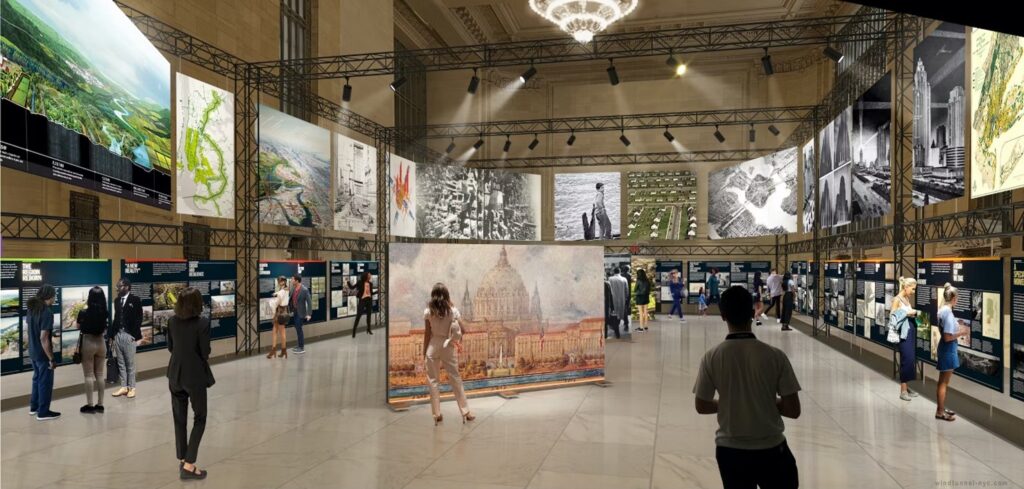
RPA’s “The Constant Future” Exhibition: Celebrating the Past and Envisioning the Future

Written by Wendy Gerber, Chief Content Strategist
For over 100 years, the Regional Plan Association has worked to create a more equitable, healthy, prosperous and sustainable region. They are now celebrating this illustrious past and reflecting on the future during their Centennial Celebration.
Capalino co-sponsored the opening reception of the RPA’s multimedia Centennial Exhibit at Grand Central, “The Constant Future: A Century of the Regional Plan.” Capalino’s President, Travis Terry, is a member of RPA’s Board and on the Executive Committee, and Capalino has worked on a number of RPA-inspired projects including The High Line and Hudson Yards, and intersected with a number of RPA’s visionary projects around transportation, climate change and neighborhood planning.
The Centennial Exhibit
Produced by architect, historian and filmmaker James Sanders, the exhibition occupies the east side of Vanderbilt Hall in Grand Central Terminal. “The Constant Future” was on view from October 7 to 24, free to the public and may travel in the future.
“Within the exhibition, dramatic photo-murals floating overhead transport visitors to a ’dream city’ of imagination and possibilities, of dazzling urban visions, built and unbuilt—and of the transformative ideas that have reshaped New York, its surrounding region, and, in time, cities all around the world. At eye-level, a series of large display panels combine engaging text, a rich array of images, and archival video sequences to trace the epic story of New York and its environs: the first urban area in the world to reconceive itself as a regional metropolis, an idea so familiar today it is almost commonplace, but a radical, innovative and daring new way of thinking in the 1920s.”
RPA’s Work
RPA is celebrating a century of research, planning and advocacy the NY-NJ-CT metropolitan region. RPA’s planners and advocates conduct research in transportation, economic development, housing, real estate, climate change, open space, and more to improve the prosperity, sustainability and quality of life of the New York metropolitan region. Formed in 1922, RPA has released four comprehensive plans to guide growth and development of tristate metro area, which has impacted economic health, environmental sustainability, and quality of life, spanning infrastructure, open space, and economic development projects. RPA has assisted in many projects including location and construction of the George Washington Bridge, creation of Gateway National Recreation Area, rebuilding lower Manhattan post 9/11, and more.
RPA’s Four Plans
RPA has released four long-range plans to guided growth and development of the tristate metropolitan area, which has impacted economic health, environmental sustainability, and quality of life, spanning infrastructure, open space, and economic development projects.
The First Regional Plan, “Regional Plan of NY and Its Environs”: Released in 1929, this plan was a major advancement in the field of urban planning, proposing a network of highways, railroads, parks, and residential and industrial centers. Many of the first Plan’s proposed highways, bridges, and parks were achieved in large part through the efforts of master builders such as Robert Moses.
The “Legacy” section of the centennial exhibit explains, “During the Great Depression, when Franklin Delano Roosevelt needed ideas for public works programs to help unemployed workers, he turned to the first Regional Plan. The Plan inspired millions of dollars in infrastructure and city-building projects.”
RPA’s advocacy prompted the purchase and preservation of large areas of open space for recreation throughout the region. In 1989, the first Regional Plan was designated a National Planning Landmark by the American Planning Association for its contributions to the field.
The Second Regional Plan: Released in 1968 at a time when wealthier white residents were leaving cities for the suburbs, RPA’s Second Regional Plan focused on the need to invest in urban centers and transit, and to reign in sprawl.
Comprised of a series of reports, the Second Regional Plan called for more federal investment in public services for low-income communities and communities of color, as well as more compact development to reduce sprawl, minimize auto travel, and protect open space. It called for the federal government to fund mass transit similarly to highways, paving the way for the MTA and creation of NJ Transit. It also called for preservation initiatives including Fire Island.
The Plan broadened the concept of public participation from simple dissemination of proposals to community engagement and consultation. In addition, RPA led the effort to create Gateway National Recreation Center, which in 1972 became the first major federal recreation area in an urban setting.
The Third Regional Plan, “A Region at Risk”: Released in 1996, the third plan warned that, without major investments in what it referred to as the “three E’s”—economy, equity, and the environment—the region would be at risk of a slow and painful recovery from the economic downturn of the early 1990s. The plan’s premise was that these three factors formed the basis of the region’s quality of life, prosperity, and vitality, and that they needed to be rebuilt together.
The Plan proposed five initiatives: Greensward, Centers, Mobility, Workforce and Governance which were designed to re-energize the region by re-greening, reconnecting and re-centering it. These strategies would try to guide the region towards sustainable growth in the 21st century.
Between the 1960s and the 1990s, the region’s highway network had grown by almost a third, while the transit network stagnated. The Third Regional Plan emphasized the importance of creating a new transportation network that could support a more concentrated form of suburban growth within the core region. RPA proposed a reconfigured Regional Express Rail system that would operate seamlessly between New York, New Jersey, and Connecticut.
The “Legacy” section of the Centennial Exhibit explains that major recommendations of the Third Regional Plan that have already been built or are in progress include Hudson Yards, Second Avenue Subway, East Side Access—LIRR connection to AirTrain (completed) and Grand Central (in progress), Governors Island, BK Waterfront Greenway, and Congestion Pricing. These projects are based in categorical recommendations (not specific ones) from the Third Plan.
The Fourth Regional Plan: Released in 2017, this plan promoted inclusive growth that would bring shared prosperity, equity, improved health, and sustainability for the region.
In the 2010s, the region’s infrastructure was deteriorating. Housing policies, local land use practices, and tax structures were inefficient and reinforced inequality and segregation. Public institutions were slow to incorporate state-of-the-art technology to improve the quality of services. The transit system was technologically outdated and couldn’t keep pace with growing ridership, as the institutions that oversaw the subways, trains, and buses were not empowered to properly invest in and upgrade infrastructure. When faced with challenges such as climate change, public institutions were slow to take action, and did so piecemeal and without adequate funding.
RPA addressed this in nine flagship areas: Jamaica, far West Side, Triboro Line, Bridgeport, Central Nassau County, Newburgh, Meadowlands, Paterson, Inner LI Sound. There was also a Four Corridors initiative in collaboration with the Rockefeller Foundation and Princeton University School of Architecture. Visit the 4c site (archived version) to learn more.
Viewing this important Centennial Exhibition
One of the world’s leading metropolitan economies, the region covered by the RPA accounts for approximately 10% of the United States GDP. Too few people share in this prosperity, however, and the pandemic has deepened economic disparities in the region.
As RPA celebrates its centennial — “RPA 100” — from 1922 to 2022, it reflects on the history of planning in the region while envisioning a sustainable future. The exhibit shares RPA’s storied history through events, papers, and engagement with the region’s residents. Capalino is proud to partner with this historic and important organization and looks forward to RPA’s work contributing to a more equitable, healthy, prosperous, and sustainable region for the next 100 years.


